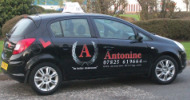|
Your Driving Test - step-by-step.
Your driving test lasts around 40 minutes in total. The test will start when you meet with the DSA examiner at the driving test centre. He/she will check both parts of your driving licence and will, as of April 2010, ask you if you want to have a supportive 'someone' in the car with you during your test. This can be a relative, a friend or your driving instructor, and will be a standard invitation issued by all driving examiners. It is your free choice whether you prefer to have someone with you, but it will, now, be actively encouraged by examiners.
You will then be asked to lead the examiner to your vehicle, where your eyesight will be checked. (
You must be able to read a standard number plate from 20.5 metres; 20 metres if it is a new style plate.
). You will be given a maximum of 3 attempts to read the plate. If after 2 attempts you cannot read the plate, the examiner will measure the exact distance to the plate.
If you cannot read the plate on your third attempt this will result in a serious fault, which means that you have failed, and the test will stop.
Presuming that the eyesight test goes okay, you lead the examiner to your vehicle where the examiner will make a few safety checks around the car. He/she will also ask you two (2) show me, tell me questions about the general knowledge, understanding and day-to-day maintenence checks that should frequently be carried out on your vehicle.
If you answer either, or both, of these questions incorrectly, you will be given a minor fault
. He/she will also ask you to make yourself comfortable in the car, in preparation for setting off on the practical drive.
Before you begin driving, the examiner will give his/her instructions clearly i.e. he/she will explain what you're to do and where you're to go. The usual, initial instruction is normally to 'follow the road ahead, obeying all the traffic signs'. If the examiner wants you to change direction (i.e. turn left, turn right, park on the left, etc.) he/she will give you plenty of warning. Once you have left the parking area at the test centre you will be expected to drive to a safe and consistent standard.
The drive will be approximately 5-6 miles, encountering various road and traffic conditions and will last approximately 30-35 minutes
.
Your instructor should have taken you on many of the roads that the examiner will ask you to drive along, therefore they should be familiar to you. Your instructor should also have taken you along roads of similar difficulty and addressed the more difficult junctions with you during your lessons. On the lead-up to your test it wouldn't do you any harm to ask him/her to take you through any particular junction that you feel less than confident about, or unclear of. Once you're on test, there's no-one to ask.
Driving skills that are examined during the test include:

You will cover all of these skills during your driving test, and some of them more than once. The test routes incorporate all types of road, and all sorts of junctions and crossings, in order to properly test a broad scope of driving skills. These are the rudimentary skills that you have practised extensively during your lessons, so keep a hold on your nerve because they should be second nature to you. Driving Skills of Primary Importance.Other major features of your driving that will be examined for both skill and consistency are: 
With these skills, the examiners are looking at safety. By the time you apply for your test the examiner knows you can drive (or else you wouldn't be up on test), but he/she needs to assess whether you can drive safely. Some of these features should be a natural part of your driving by this time. But many are neglected, like 'correct use of mirrors', or there is a need for you to show to the examiners that you have confidence in your own knowledge of the road, such as 'safe road positioning'. This is the 'thinking' and 'decision-making' part of driving. It's the 'safety' part that you'll address everyday, every time you drive, once you're a qualified driver. And these are the driving skills that most people fail on. This can sometimes be due to an over-reliance on your driving instructor to do the thinking for you during your driving lessons. It's something that your instructor will encourage you to do for yourself, especially on the lead-up to your driving test. Your instructor will do this by asking you questions about what you think you should be doing e.g. on approach to a junction, and he/she will ask you why you opt to do it the way you do. This phase of your driving lessons is the phase where he/she is encouraging you, the learner, to take control of the car by making decisions based on your knowledge, using the skills you've learned. It's about applying your driving skill in a safe way. It needs committment, and a lot of focus on the part of the learner. But it pays dividends if it's given the proper attention it deserves. It allows you to build up your own confidence in your knowledge of the road, and enables you to have faith in your own decision-making in different driving situations, whilst you're still in a safe environment. However, confidence in your own decision making is unlikely to fully develop until you are licenced and 'on-the-road', and you don't have that other person to double-check everything with. But you can take those first steps during your lessons, which makes all the easier when you pass your test and start going out on your own. These skills are important during your driving test, but they're so, so important for your driving overall. The Secondary Controls.During your driving test, you should also be confident in the use of the secondary controls of the car, such as: 
These are the secondary controls that your instructor would have shown you, and you would have used, at different times throughout your lessons. It does no harm to go over them with your instructor in the few weeks leading up to your test. Ideally, you should try explaining to him/her where they are and what they're all for, rather than ask him/her to tell you about them again. That way, your learning will be better consolidated. The Driving Manoeuvres.During the driving test, you will also be given 1 set exercise to complete. You will have covered all of these driving manoeuvres during the course of your driving lessons. The examiner will randomly select one of the following: 
You may also be asked to perform the emergency stop exercise. The examiner can ask you to do the set exercises in any location. It is likely that the location that the examiner selects for you to perform a manoeuvre will be similar to a location that you have already used for practise, whilst on your lessons. During your driving test the examiner will be aware that you may be nervous, understandably, and will do the utmost to make the situation as calm and relaxing as possible. At a number of points during your driving test, the examiner may ask you to 'pull in and park'. If you wish, you can also ask to stop, for a minute or so, to re-compose yourself before proceeding. However, it is also not uncommon for test candidates, as the test progresses, to relax a bit and focus on the drive, rather than the examiner. Don't be surprised if you respond like this. But, overall, try not to worry if you make a mistake. It may not be as bad as you think it is. Try your best to put it out of your mind and remain focused on the rest of your driving test.
This enables both you, and your instructor, to have a clear picture of which areas of your driving need improvement, whether you pass or fail. If you have passed, you can attempt to address these areas for yourself. Alternatively, you and your instructor may take the opportunity to rectify these in a Pass Plus course. If you fail your driving test, your instructor will actively address these areas, during your lessons, on the lead up to your next test. The driving instructor always drives test candidates home after their driving test. Practical tests engender heightened emotions from candidates, and it's commonly accepted that driving under extreme emotion, either elation or despair, is unsafe. Therefore, at the end of your driving test, your instructor will drive you home, where he/she will drop you off. End of driving test! We hope this page has been of some help, and made your driving test a little less daunting, and a little more 'known' to you. Our next page, Independent Driving , explains what this new section of the practical Driving Test is all about. Or you could have a look at After the Test , which explains in detail what happens immediately after the driving test, both if you have successfully passed your test and if you've been unfortunate enough to fail. Next Page - Independent Driving
|

